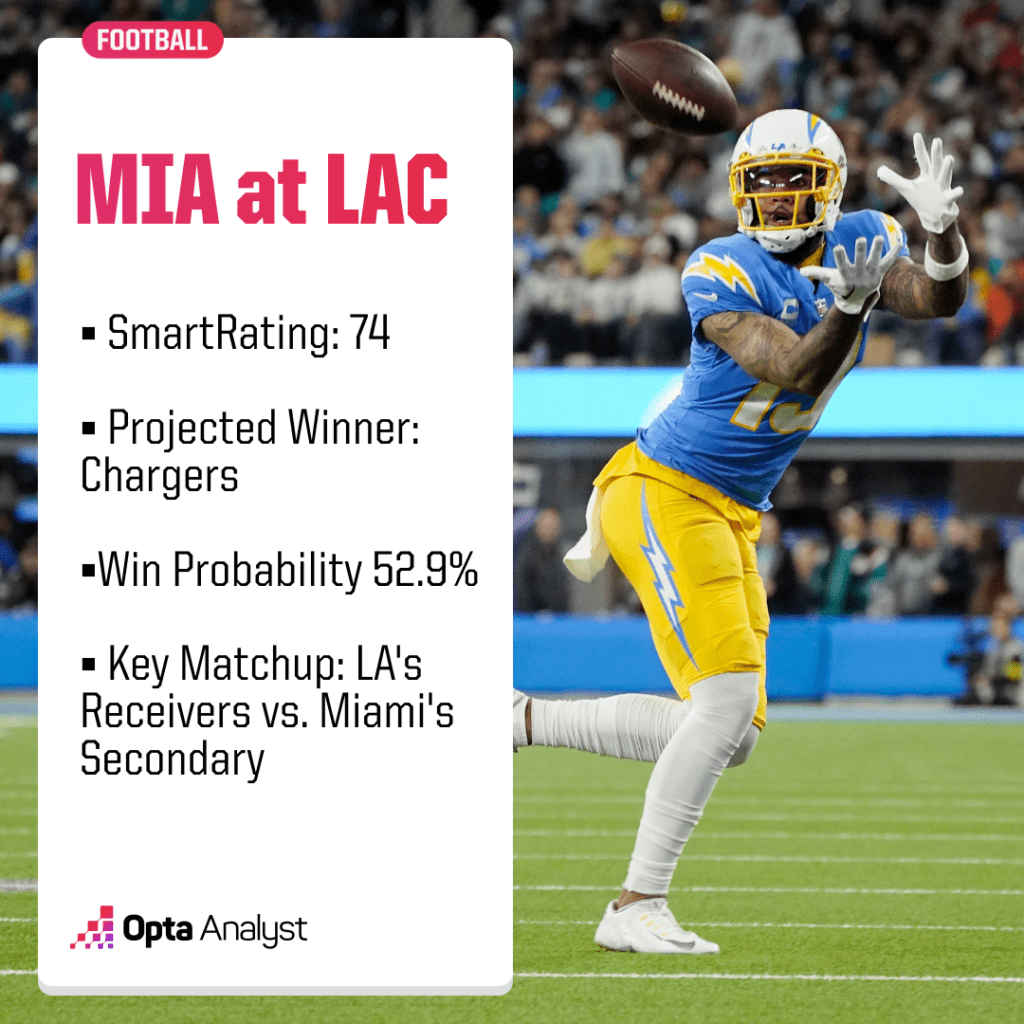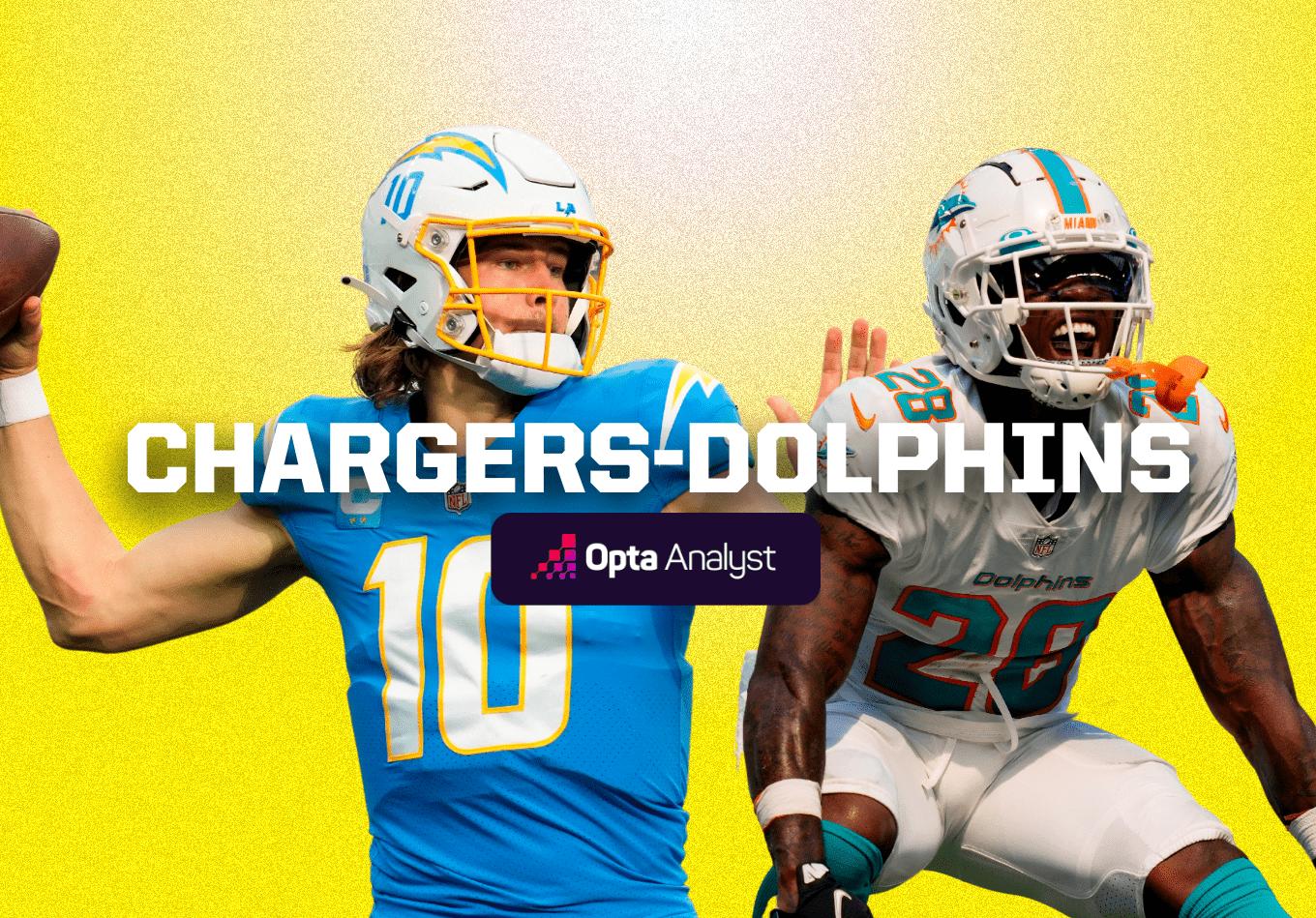It’s projected to be the third-most exciting game on the Week 1 schedule, according to SmartRatings. Two AFC teams who figure to be in the playoff conversation clash in California. And we’re breaking down the key matchup in the Los Angeles Chargers-Miami Dolphins showdown.
It’s Week 1 of the NFL regular season, so that must mean playoff positioning is on the line.
Wins are so precious in the 18-week season, and securing a victory against an intra-conference opponent can go a long way in locking up a playoff spot come season’s end.
A pair of AFC teams who figure to be in the postseason conversation with dreams of making a Super Bowl run come December clash in Southern California in early September with the Miami Dolphins taking on the Los Angeles Chargers at SoFi Stadium in Inglewood.
Our NFL projection model gives the Chargers a 42.9% chance of making the playoffs and predicts they’ll finish with 8.8 wins out of the tough AFC West. (Yes, teams can’t finish the season with eight-tenths of a win, but that’s the number our supercomputer churned out while putting a win-loss percentage on each game.) The Dolphins are projected to win 7.9 games and have a 28.1% chance of reaching the postseason.
So although their final record is separated by less than a win, that is nearly a 10% difference between making the playoffs and staying home.
So again, getting a victory in Week 1 could have huge implications on the final standings. It’s also projected to be the fourth-most exciting game on the schedule, according to SmartRatings.

These teams met on a Sunday night in Week 14 last year, with Los Angeles holding on for a 23-17 win. That victory moved the Chargers into a playoff spot – a position they would not relinquish as they would go on to reach the postseason for the first time since 2018 but blow a huge lead to the Jacksonville Jaguars in the wild-card round.
The Dolphins also made the playoffs last season, the first time for them since 2016, but they sure didn’t make it easy on themselves thanks to a five-game losing streak spanning Weeks 13-17. They needed an ugly 11-6 win over the New York Jets in Week 18, coupled with a New England Patriots loss to the Buffalo Bills, to reach the playoffs.
The quarterbacks of these teams will forever be linked with the Dolphins selecting Tua Tagovailoa fifth overall in the 2020 NFL Draft and the Chargers selecting Justin Herbert with the very next pick.
In last year’s matchup, Herbert completed a career-high 39 passes for 367 yards and one touchdown, while Tagovailoa had one of the worst starts of his career, completing just 35.7% of his 28 pass attempts for 145 yards with a TD for a 65.3 QB rating. Tyreek Hill had four catches for 81 yards and a touchdown, but Jaylen Waddle was held to two receptions for 31 yards.
Statistically, Herbert is among the upper echelon of quarterbacks. His 4,739 passing yards last season trailed only Kansas City Chiefs star Patrick Mahomes’ 5,250, and his 14,089 career passing yards are the most by a QB in his first three seasons in NFL history. His 94 passing touchdowns since 2020 also rank sixth.
His season and career totals are impressive, and the Chargers have rewarded Herbert by making him the highest-paid QB in NFL history this offseason. (Joe Burrow surpassed Herbert on Thursday when he signed his megadeal with the Cincinnati Bengals.)
But while he’s been piling up the passing yards, Herbert wasn’t running the most efficient offense.
The Chargers were 22nd in offensive EVE (efficiency vs. expected yards) last season – averaging 0.256 fewer yards than expected on offensive plays – and among the 35 QBs with at least 175 attempts last season, Herbert’s average of 6.68 air yards per attempt beat out only Matt Ryan and Daniel Jones.
Fewest Air Yards per Attempt – 2022 (Min. 175 Attempts)
- Daniel Jones, New York Giants (6.47)
- Matt Ryan, Indianapolis Colts (6.53)
- Justin Herbert, Los Angeles Chargers (6.68)
- Matthew Stafford, Los Angeles Rams (6.70)
- Kyler Murray, Arizona Cardinals (6.70)
Top targets Keenan Allen and Mike Williams only played in 10 and 13 games, respectively, though both were in the lineup when Herbert dinked and dunked Los Angeles down the field in last year’s matchup with Miami. He averaged 5.48 air yards per pass on his 51 attempts with only two pass plays going for 20+ yards.
The passes were on point, though, as 91.7% of them were considered catchable balls.
In 2022, Herbert did a terrific job at spreading the ball around, as Los Angeles became the first team in NFL history to have six different players with at least 45 receptions, but again, the team struggled to move the ball downfield.
The Chargers averaged 5.29 yards per offensive play (the NFL average was 5.40) and the only playoff team to average less was the Tampa Bay Buccaneers, the default winners of the lousy NFC South with an 8-9 record, at 5.09.
The hope is the offense takes a major step forward and becomes more vertical while not totally abandoning the running game under new offensive coordinator Kellen Moore.
Los Angeles was the second-most unbalanced team in the NFL last season, passing on 65% of its offensive plays – only the Bucs passed more (66.7% of the time).
Between Herbert, running back Austin Ekeler, tight end Gerald Everett and wide receivers Allen, Williams, Joshua Palmer and first-round pick Quentin Johnston, whose average of 17.8 yards per reception last season at TCU ranked fourth among the 140 FBS receivers with at least 50 catches, the offense sure has the firepower to be explosive.
Tasked with slowing down the new-look Chargers is a Miami team that was essentially average by most defensive metrics last season, ranking 16th in defensive EVE (-0.109) and 14th in opponent yards per play (5.29).
Though it wasn’t surrendering big plays, the defense struggled to get off the field, ranking 22nd in scoring efficiency with opponents ending 37.5% of all drives with either touchdowns or field goals.
This offseason, the team brought in the respected Vic Fangio to run the defense in hopes of shoring up the unit.
The Dolphins also traded for All-Pro cornerback Jalen Ramsey from the Rams in March to play opposite Xavien Howard, but Ramsey is beginning the season on the PUP list after suffering a torn meniscus in his left knee in the preseason. The team then brought in free agent Eli Apple to provide depth in the secondary, though it already has a cornerback on the roster ready to step in for the injured Ramsey.
No player was targeted at more in 2022 than Kader Kohou, who was thrown at 94 times. The first-year corner responded with a strong season, intercepting one pass while defending 10. He was one of the best in the league in not being beaten by his man, registering a burn-allowed percentage of 41.5 – eighth in the NFL among the 55 players targeted at least 60 times.
And among those corners who were picked on the most, Kohou was one of the most dependable.
Lowest Burn-Allowed Percentage – 2022 (Min. 75 Targets)
- Martin Emerson Jr., Cleveland Browns (39.3)
- Michael Davis, Los Angeles Chargers (40.5)
- Kader Kohou, Miami Dolphins (41.5)
- Stephon Gilmore, Indianapolis Colts (42.2)
- Charvarius Ward, San Francisco 49ers (43.0)
Not bad for an undrafted rookie out of Texas A&M-Commerce.
Kohou was also rarely beaten for gains of 20-plus yards since Week 6, producing a big play-allowed percentage of 17.5 – the NFL average was 24.8% in that span.
On the season, the surprising Kohou was burned at a smaller rate than the veteran Howard, who registered a burn-allowed percentage of 51.4 – slightly below the NFL average of 50.8. Howard, though, did a good job of covering his man on passes thrown to him, registering an open-allowed percentage of 61.1. The league average for open-allowed percentage in 2022 was 68.4.
The Dolphins secondary appears to have the edge going up against the Chargers receivers given that none of their numbers jumped off the page, but that was under last year’s system.
Palmer had an open percentage of 76.6 – 16th in the league among the 54 receivers targeted at least 75 times last season – Allen had an open percentage of 76.1 – 19th in the NFL – while Williams had the league’s second-lowest open percentage at 53.8. The NFL average for open percentage was 72.1.
None of the receivers were beating opposing defensive backs with much regularity either, with Palmer recording a team-best 65.4 burn percentage – 17th in the NFL. Allen registered a 61.4 burn percentage, while Williams was at 57.0. The average burn percentage in 2022 was 60.0.
While neither Allen nor Williams did much to help Herbert in terms of creating significant separation last season, those two proved to be dependable when he threw the ball on target in their direction.
Highest Catch Rating by Wide Receivers – 2022 (Min. 75 Targets)
- Kennan Allen, Los Angeles Chargers (0.964)
- Cooper Kupp, Los Angeles Rams (0.955)
- Amon-Ra St. Brown, Detroit Lions (0.951)
- Tyler Boyd, Cincinnati Bengals (0.943)
- Mike Williams, Los Angeles Chargers (0.940)
So although Allen and Williams weren’t considered two of the most dangerous playmakers, it would seem the Chargers could still move the ball downfield by throwing to two of the most sure-handed receivers in the game.
Herbert has the arm to do that, considering he ranked sixth among qualifiers last season in well-thrown percentage (84.8) and eighth in catchability rating (81.7).
The ingredients are there for the Los Angeles offense to take the next step. We’ll see what kind of treat Moore comes up with for facing Fangio.
